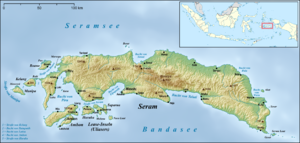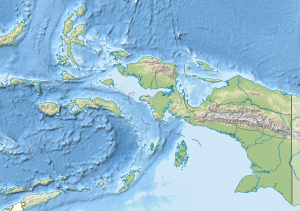Seram
| Seram | ||
|---|---|---|
| Seram | ||
| Waters | Seramsee , Banda Lake | |
| Archipelago | Moluccas | |
| Geographical location | 3 ° 5 ′ S , 129 ° 19 ′ E | |
|
|
||
| length | 320 km | |
| width | 70 km | |
| surface | 17,100 km² | |
| Highest elevation |
Mount Binaiya 3027 m |
|
| Residents | 218.993 (2013) 13 inhabitants / km² |
|
| main place | Masohi | |
| Location of Seram in the Moluccas | ||
Seram (formerly Ceram ) is with 17,100 km² the second largest island in the Moluccas archipelago and belongs to the Indonesian province of Maluku (Southern Moluccas). The main town is Masohi in the center of the island, on the south coast.
geography
Seram is located in the Pacific Ocean , between the Banda Sea in the south and the Seram Sea in the north, about 550 km east of Sulawesi , 220 km south of Halmahera , 150 km west of New Guinea and 560 km northeast of Timor . The geographical position of the island is between 3 ° and 4 ° south latitude and between 128 ° and 131 ° east longitude. It measures about 320 kilometers from west to east and 70 kilometers from north to south.
The island is mountainous and covered with tropical rainforest and is very sparsely populated. The highest mountain on the island is Mount Binaiya ( Gunung Binaiya ) with 3,027 meters in the middle of the island. The area around the mountain is protected as Manusela National Park.
About ten kilometers of sea in a south-westerly direction separate the places Rumahkal on Seram and Liang on the island of Ambon . There is also Ambon , the provincial capital of Maluku. To the east of Ambon are the Lease Islands with Haruku and Saparua .
In the west, off the coast, are the islands of Manipa , Kelang and Boano .
In front of the eastern tip of Seram, there are other small and inhabited islands, including:
- The Geser Atoll with a diameter of less than 1 km is 2 km away .
- 500 m further on is the larger, 4 km long, hilly island of Seram Laut .
fauna
21 endemic bird species live on Seram. However, many parrot species are threatened despite protective regulations. Bird trapping is an important source of income for the local population.
religion
The majority of Seramese are Muslim. Christians are mainly found in the west and interior of the island. Christianity spread in the early 20th century. Not by the Dutch colonial rulers, but by Indonesian missionaries from Ambon. With traders in the port towns, Islam came to the coastal regions. Some Balinese immigrants are Hindus. The domestic population, summarized under the derogatory name of Alfuren , still partly adheres to natural religious beliefs. An example of such beliefs that belong to the dema conceptions is the myth of the Hainuwele of the original population group of the Wemale .
history
Seram was owned by the Sultans of Ternate until it was conquered by the Dutch . Portuguese missionaries had a great influence on the island in the 16th and 17th centuries. In 1650 Seram finally became Dutch property.
Transport and traffic
Seram can be reached primarily from the island of Ambon. Merpati has flights from Ambon City to Masohi and Wahai . There is a ferry connection between Liang on Ambon and Kairatu on Seram. There is also a speedboat connection from Tulehu on Ambon, directly to Masohi. Another port on Seram is Amahai , five kilometers southeast of Masohi.
The road network on Seram surrounds the western part of the island and extends to Tehoru in the east . Most of the roads in the north are in poor condition. A road runs right through Seram from Masohi to Wahai on the north coast. The towns of Kobi and Bula on the northeast coast can also be reached by car. Public buses, shared taxis and motorcycle taxis ( ojeks ) run on most roads .
literature
- Ian Darwin Edwards (Ed.): Natural History of Seram: Maluku, Indonesia. Intercept, Bedfordshire 1993
- Adolf Ellegard Jensen : The three streams. Traits from the spiritual and religious life of the Wemale, a primitive people in the Moluccas. Harrassowitz Verlag, Leipzig 1948
- Adolf Ellegard Jensen, Hermann Niggemeyer: Hainuwele . Folk tales from the Moluccan island of Ceram . Vittorio Klostermann, Frankfurt am Main 1939
Web links
Individual evidence
- ↑ Travel information
- ↑ a b c d Maluku Travel Information: Seram: The Mother Island of Central Maluku



